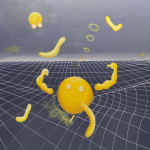

Hugo Lami Portugal, b. 1994
Floating Emojionless, 2021
Oil on canvas.
170 x 150 cm
66 7/8 x 59 1/8 in
66 7/8 x 59 1/8 in
Designer Shigetaka Kurita is considered the founding father of today's emojis. In 1999, NTT DOCOMO, a Japanese cell phone company, released a set of 176 emojis for cell phones and...
Designer Shigetaka Kurita is considered the founding father of today's emojis. In 1999, NTT DOCOMO, a Japanese cell phone company, released a set of 176 emojis for cell phones and pagers. Emoji is a mixture of two Japanese words: Image and letter. (It is pure coincidence that "emoji" sounds like it is derived from the English word "emotion.") Kurita used Japanese graphic novels and the Zapf Dingbats font, as well as illustrations and pictograms, to create the first emoji library. The pixelated designs that eventually became today's extensive emoji database are on display at MoMa.
We communicate and interact with each other through emotion, but when we text, we lose the sense of feeling and become disconnected from our emotions. Lami's work shows an emoji without expression. It shows that emojis can not really replace our facial expressions. How often do we send emojis that do not match our real feelings?
We communicate and interact with each other through emotion, but when we text, we lose the sense of feeling and become disconnected from our emotions. Lami's work shows an emoji without expression. It shows that emojis can not really replace our facial expressions. How often do we send emojis that do not match our real feelings?


